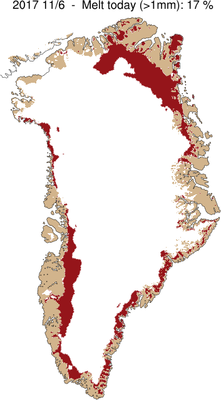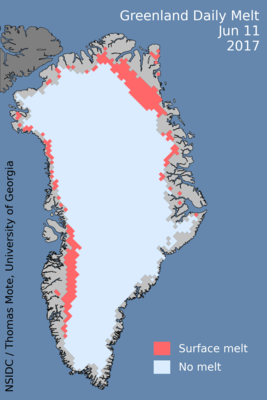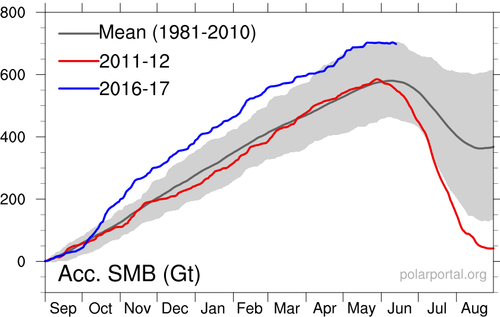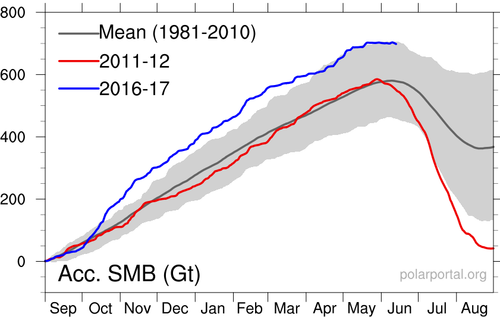Ablation season onset 2017: Not late, not early – just normal
15 June, 2017
This summer’s ablation season began on June 11 – the first of three days in a row with more than one gigatonne mass loss across Greenland. This date places this year on a shared 12th place over the 1981-2017 period, just one day from June 12, which is the median of the list (same number of events before and after).
At DMI, we define the beginning of the ablation season as the first day of a period of at least three consecutive days where surface mass balance (SMB) is negative and below –1 Gt/day (one gigatonne, Gt, is one billion tons and corresponds to 1 cubic kilometer of water). A negative SMB of 1 Gt means that one Gt of ice is lost from Greenland.
After a very snowy winter on the Greenland Ice Sheet , this occurred on June 11, with -1.5, -1.8 and -2.0 Gt on June 11, 12 and 13. This date places 2017 on a shared 12th place on the list of ablation onset dates since 1981. The middle of the list (the so-called median) is June 12, and this year is therefore a very normal year in comparison to the 36 preceding ablation onsets. In fact, even in comparison to the years since 2000, this date is at the middle of the list.
As normal as they come
Climate scientist at DMI, Ruth Mottram, says “This year really is as normal as they come in terms of ablation onsets. We have had a lot of snow on the ice sheet this winter and despite a rather early onset of the melting season, actual ablation hasn’t occurred in large amounts before now.” The melting season - the first day of a period of at least three consecutive days where more than 5% of the ice sheet experiences melting - began on May 5 this year, ranking it 3rd since 1981.
Not only were there large amounts of snowfall in winter – also spring ended with more snowfall along the east coast of Greenland. Martin Stendel, climate researcher at DMI, gives an example: “Tasiilaq on the east coast observed 270.5 mm precipitation, most of that as snow, in spring 2017. This is 27% more than the average 1981-2010, which amounts to 213.3 mm.”
Ruth Mottram continues, “It is quite likely that the large amounts of snow have delayed the onset due to the ability of fresh snow to refreeze meltwater produced at the surface”.
Martin Stendel explains: “Even though that sounds paradoxical, the relatively late onset of the ablation season may be related to the warm winter 2016/2017 in the Arctic. Beginning in October 2016, several weather events were observed with warm and moist air flowing into the Arctic from the North Atlantic. As a result, every month from October 2016 to March 2017 was much warmer than the average along the Greenlandic east coast and in most of the inner Arctic – but still below the freezing point. As warmer air can hold more water vapor than colder air, the consequence will be more snowfall.” This has perhaps delayed the onset of ablation.
It is, however, too early to say how the ablation season 2017 will end. As the graphic shows, almost all of the ablation takes place in July and August.
Polar Portal is a collaboration between DMI, GEUS, DTU-Space and DTU-Byg with funding from the Danish Energy Agency (Energistyrelsen).
Polar Portal is also on Twitter: @PolarPortal and Facebook: https://www.facebook.com/PolarPortal/.









